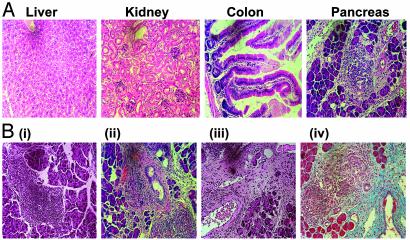Fig. 4.
Activated dnTGFβRII CD8+CD44+ T cells induce diabetes and pancreatitis. (A) Recipients of dnTGFβRII CD8+CD44+ T cells that developed diabetes 2 days posttransfer of the donor cells were killed, and the liver, kidney, colon, and pancreas were removed. After fixation in 10% formalin, 5- to 7-μm sections of paraffin-embedded tissue were stained with hematoxylin (nucleusstaining purple) and eosin (cytoplasmic-staining pink). The data are representative of four individual mice examined. (B) The pancreata were removed from new diabetic recipients of non-tg (i) or dnTGFβRII (ii) CD8+CD44+ T cells, and tissue sections were stained with hematoxylin/eosin as before. The data are representative of two individual mice examined from each group. Alternatively, recipients of dnTGFβRII CD8+CD44+ T cells that became diabetic 2 days posttransfer were treated with 2 units/ml insulin s.c. for 48 h, after which the pancreas was removed. Tissue sections were stained either with hematoxylin/eosin (iii) or Masson's trichrome (iv). The data represent two individual mice examined.

